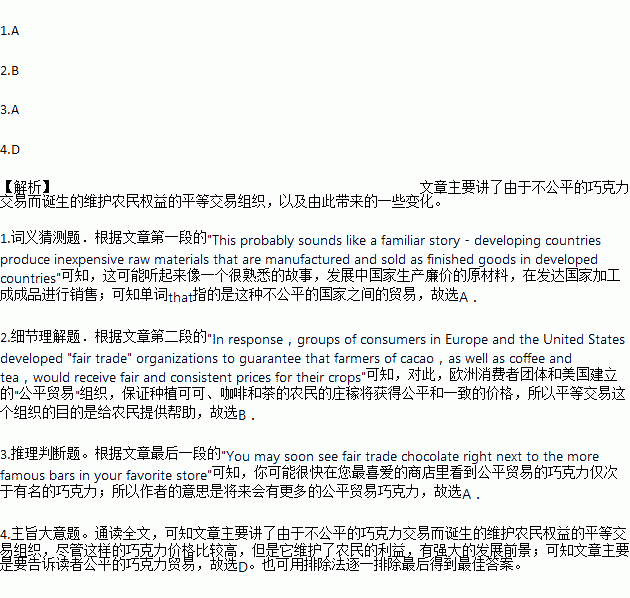题目内容
Have you ever wondered where the chocolate in your favorite candy bar comes from? Choco-
late comes from the cacao tree, which grows in warm, tropical areas of West Africa, Indonesia, Malaysia, Mexico, and South America. And who eats the delicious chocolate made from the cacao grown in these places? The majority of chocolate is consumed in Europe and North America. This probably sounds like a familiar story-developing countries produce inexpensive raw materials that are manufactured and sold as finished goods in developed countries, and generally, that is what happens with chocolate. Large chocolate companies buy cacao beans at a low price and produce cocoa and chocolate products to sell at a relatively high price.
But the familiar story has a new chapter. Beginning in the 1980s, some consumers learned that cacao farmers were living difficult and uncertain lives. The farmers received money for their crops based on world markets, and the market price for cacao was sometimes so low that farmers received less for their crops than the crops had cost to produce. In response, groups of consumers in Europe and the United States developed "fair trade" organizations to guarantee that farmers of cacao, as well as coffee and tea, would receive fair and consistent prices for their crops.
Fair trade organizations benefit farmers by buying cacao beans or other products from them directly at higher-than-market prices and eliminating(消除)“middle men" such as exporters. Fair trade organizations also encourage farming techniques that are not harmful to the environment or to farm workers. for example, growing cacao without chemical pesticides or fertilizers in the shade of rain forest trees.0ne organization, Equal Exchange, helps farmers set up farming cooperatives in which they can share resources and work on projects such as community schools. Another, Fairtrade Labelling Organizations International(FLO),guarantees that products bearing its label meet standards that improve the lives of growers and producers.
The results of fair trade are a better standard of living for some farmers and nicer chocolate bars made with organically produced cocoa that consumers don't feel guilty about buying. And al- though fair trade chocolate is somewhat more expensive than other chocolate and now makes up only 1% of chocolate sold, the fair trade idea is spreading quickly. You may soon see fair trade chocolate right next to the more famous bars in your favorite store.
1.The underlined word“that”in Paragraph l refers to .
A. the unfair trade between countries
B. the high price of chocolate products
C. the traditional production of raw materials
D. the major consumption of the finished food
2.The organization Equal Exchange aims to .
A. promote chocolate sales
B. offer support to the farmers
C. reduce the cost of growing crops
D. increase the production of chocolate
3.What does the author imply in the last paragraph?
A. There will be more fair trade chocolate ill the future.
B. Fair trade chocolate is not as tasty as other chocolate.
C. Consumers feel guilty about buying fair trade chocolate.
D. There is probably no reason to worry about cacao farmers.
4.The passage mainly talks about .
A. giving tips on how to undertake fair chocolate trade
B. advising people to join in Fair trade organizations
C. encouraging farmers to adopt organic farming
D. informing people of fair trade chocolate


 about what construction to use, you begin to stammer, stop sounding natural. Your responses should become automatic to master the language, so instead of studying theory – take more practice! When you speak, you don't have time for considering what tense is appropriate, one hundred percent correct. 2. Grammar is important in writing, not in speaking.
about what construction to use, you begin to stammer, stop sounding natural. Your responses should become automatic to master the language, so instead of studying theory – take more practice! When you speak, you don't have time for considering what tense is appropriate, one hundred percent correct. 2. Grammar is important in writing, not in speaking.